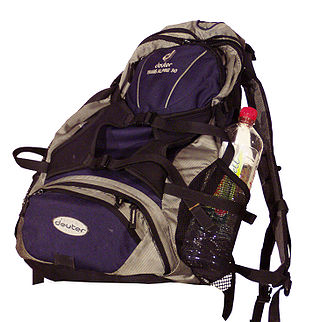
A backpack—also called knapsack, rucksack, pack, booksack, bookbag, or backsack—is, in its simplest frameless form, a fabric sack carried on one's back and secured with two straps that go over the shoulders, but it can have an external frame, internal frame, and there are bodypacks.

A pocket is a bag- or envelope-like receptacle either fastened to or inserted in an article of clothing to hold small items. Pockets are also attached to luggage, backpacks, and similar items. In older usage, a pocket was a separate small bag or pouch.
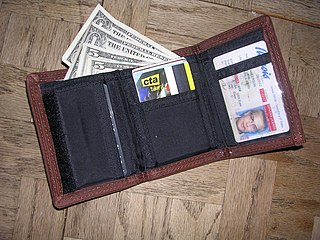
A wallet is a flat case or pouch, often used to carry small personal items such as physical currency, debit cards, and credit cards; identification documents such as driving licence, identification card, club card; photographs, transit pass, business cards and other paper or laminated cards. Wallets are generally made of fabric or leather, and they are usually pocket-sized and foldable.

The sporran, a traditional part of male Scottish Highland dress, is a pouch that functions as a pocket for the kilt. Made of leather or fur, the ornamentation of the sporran is chosen to complement the formality of dress worn with it. The sporran is worn on a leather strap or chain, conventionally positioned in front of the groin of the wearer.

A handbag, commonly known as a purse in North American English, is a handled medium-to-large bag used to carry personal items. It has also been called a pocketbook in parts of the U.S.
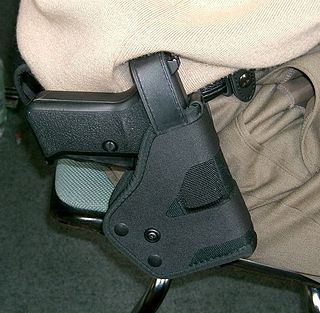
A handgun holster is a device used to hold or restrict the undesired movement of a handgun, most commonly in a location where it can be easily withdrawn for immediate use. Holsters are often attached to a belt or waistband, but they may be attached to other locations of the body. Holsters vary in the degree to which they secure or protect the firearm. Some holsters for law enforcement officers have a strap over the top of the holster to make the handgun less likely to fall out of the holster or harder for another person to grab the gun. Some holsters have a flap over the top to protect the gun from the elements.

A briefcase is a narrow hard-sided box-shaped bag or case used mainly for carrying papers and equipped with a handle. Lawyers commonly use briefcases to carry briefs to present to a court, hence the name. Businesspeople and other white collar professionals also use briefcases to carry papers, and since the 1980s, electronic devices such as laptop computers and tablet computers. Some briefcases have only a main internal space, while others may have subsections, accordion sections, small pockets, or dividers. Briefcases may be made from leather, vinyl, durable fabric, thin metal, or plastic. Leather, vinyl, or fabric briefcases may have externally-accessible pockets or sleeves in addition to the main storage space. Some briefcases made of fabric may have a shoulder strap. Briefcases typically have a lock to protect the contents. Nowadays, briefcases may have padded internal pouches to protect laptop computers.

A waist bag, fanny pack, belt bag, moon bag, belly bag, or bumbag is a small fabric pouch worn like a belt around the waist by use of a strap above the hips that is secured usually with some sort of buckle. The straps sometimes have tri-glide slides, making them adjustable in order to fit properly. It can be considered as a purse worn around the waist.

A messenger bag is a type of sack, usually made of cloth. It is worn over one shoulder with a strap that goes across the chest resting the bag on the lower back. While messenger bags are sometimes used by couriers, they are now also an urban fashion icon. Some types of messenger bags are called carryalls. A smaller version is often called a sling bag.
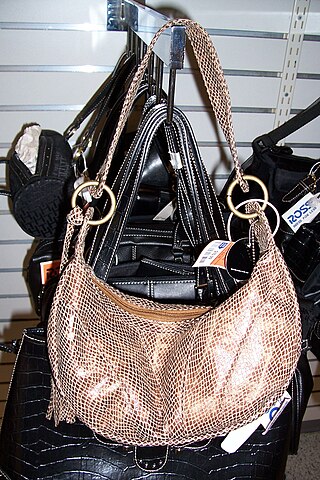
The hobo bag is a style of handbag or purse that is typically large and characterized by a crescent shape, a slouchy posture and a long strap designed to wear over the shoulder. Hobo bags are made out of soft, flexible materials and tend to slump, or slouch, when set down. There are many different sizes and shapes of this popular woman's fashion accessory.
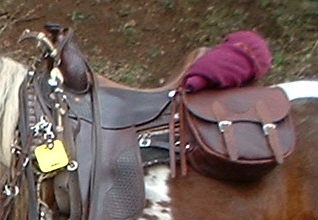
Saddlebags are bags that are attached to saddles.

Longchamp is a French leather goods company, founded in Paris in 1948 by Jean Cassegrain. The company pioneered luxury leather-covered pipes before expanding into small leather goods. Longchamp debuted women's handbags in 1971, becoming one of France's leading leather goods makers. Today, the company designs and manufactures leather and canvas handbags, luggage, shoes, travel items, fashion accessories, and women's ready-to-wear. The house is privately owned and managed by the Cassegrain founding family and does business in 80 countries through around 1,500 retail outlets.

The Chanel 2.55 is a luxury leather handbag or purse manufactured by the fashion house of Chanel.

Hervé Chapelier is a French fashion accessories company based in Paris that specializes in handbags.

Kate Spade New York is an American luxury fashion house founded in January 1993 by Kate and Andy Spade. In 2017, the company was purchased by Tapestry, Inc., formerly known as Coach, Inc.

A bag is a common tool in the form of a non-rigid container, typically made of cloth, leather, paper or plastic. The use of bags predates recorded history, with the earliest bags being lengths of animal skin, cotton, or woven plant fibers, folded up at the edges and secured in that shape with strings of the same material. Bags can be used to carry items such as personal belongings, groceries, and other objects. They comes in various shapes and sizes, often equipped with handles or straps for easier carrying.
The Duluth Pack company is a manufacturer and supplier of Duluth pack style packs. They also produce and sell a range of other products, especially other bags and accessories built in the style of their packs. The company grew out of the shoe repair business started by Camille Poirier in 1870. He patented the #3 Duluth pack in 1882 and later sold the canoe pack business to an outdoor supply store in downtown Duluth, Minnesota, where it is still located. The company is led and owned by Tom Sega.
Valextra is a brand of luxury leather goods and accessories based in Milan, Italy. The name is a portmanteau of "Valigia", the Italian word for suitcase, and "extra".
Lancel is a French Maison of luxury leather goods, founded in Paris in 1876 by Angèle and Alphonse Lancel and developed by their son Albert.
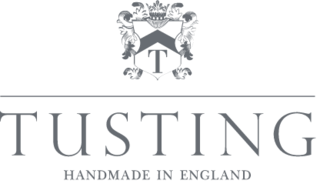
Tusting is a British leathergoods maker known for its luxury handbags and luggage. The firm was founded in 1875 and operates from a factory in the village of Lavendon, Buckinghamshire.


















